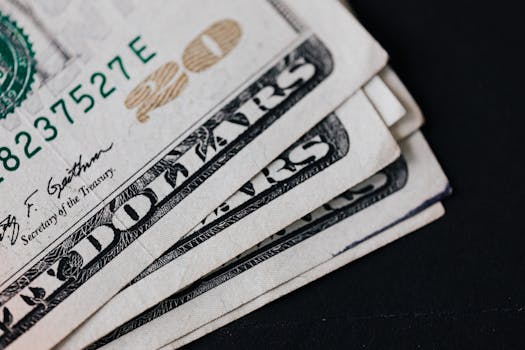Financial literacy
How to Build Financial Resilience in Uncertain Times
Discover real-world steps to boost your financial resilience now. Create safety nets, set goals, adapt habits, and diversify income—all with practical rules you can start today for true security.
Advertisement
Anyone who’s watched their paycheck stretch less or an emergency wipe out savings knows the value of a solid safety net. Financial resilience isn’t about avoiding problems—it’s about being ready when life’s surprises show up.
Economic swings, job changes, or medical bills can land without warning. That’s when financial resilience becomes more than a buzzword. Having a plan means you’ll face challenges with confidence and bounce back faster, no matter what.
This article walks you through actionable steps for greater financial resilience. You’ll learn proven habits, smarter saving moves, and practical scripts to help you stay afloat—and thrive—through any kind of uncertainty.
Setting Strong Ground Rules: Emergency Funds that Actually Work
An emergency fund shields you from unexpected costs and helps prevent debt. Figure out three months of essentials—rent, food, and utilities—then use that number as your savings goal.
Start by automating transfers so your money grows steadily. Repeat the process with each paycheck, no matter the amount, and watch your financial resilience compound over time.
Choosing the Right Account for Your Emergency Savings
Keep emergency funds in a separate, high-yield savings account. This keeps everyday cash and emergency reserves distinct—and discourages dipping in for non-essentials.
Look for accounts with no monthly fee and quick transfer access. When you see an enticing new gadget, remind yourself these funds are firewall: emergencies only.
As an example, if you’d say, “I can buy this and just replace the money later,” use that as your trigger to pause and rethink.
Automating Contributions for Lasting Results
Automate a set amount—$25, $100, whatever suits—right after payday. Setting this on autopilot beats relying on willpower or memory every month.
If your paycheck varies, set a minimum transfer but allow for larger amounts when extra cash comes in. Consistency is more valuable than sheer size in building resilience.
Check your auto-transfer after three months to ensure you’re comfortable and adjust up or down as needed for your lifestyle.
| Emergency Fund Feature | Why It Matters | What To Watch For | Takeaway |
|---|---|---|---|
| Separate Savings Account | Prevents temptation | Must be easy to access in emergencies | Open a no-fee, dedicated account |
| Automatic Transfers | Ensures regular savings | Check minimum balance rules | Set up autopay today |
| Minimum Three Months’ Expenses | Covers typical emergencies | Adjust for household size or job stability | Calculate your number now |
| Easy Online Access | Quick for true emergencies | Avoid accounts with transfer delays | Test withdrawal speed first |
| Annual Savings Checkup | Ensures adequacy | Update as expenses change | Review savings every year |
Cultivating Consistent Saving and Spending Habits
Building financial resilience means putting repeatable habits in place. A clear spending plan keeps your money anchored to what matters most.
List essentials, flexible categories, and luxury spends. This transparency curbs waste and spots areas for quick savings if your financial picture changes suddenly.
Designing Simple Monthly Budgets
Break your budget into three buckets: needs, wants, and savings. Assign every dollar before payday and keep receipts or a spreadsheet for weekly check-ins.
A statement like, “I’ll track my grocery spending and adjust mid-month if needed,” helps reinforce discipline. Flexibility is just as valuable as strictness in uncertain times.
- Track daily expenses using an app or notebook—this provides real-time accountability and reveals patterns over time.
- Set specific limits for non-essential categories, such as dining out—by deciding in advance, you reduce the risk of overspending on impulse.
- Review your bank statement weekly—frequent check-ins catch problems or fees early, protecting your financial resilience from slow leaks.
- Put all extra income—like tax refunds or bonuses—directly into savings, at least partly, to boost your emergency fund without feeling deprived.
- Choose one luxury to cut back on each month—keep it realistic, like skipping one coffee run a week, and redirect that cash to savings.
Rotate through these steps consistently and they’ll become second nature, even when stress or change hits your income or bills.
Managing Variable Incomes or Sudden Expenses
People with seasonal or gig jobs see income rise and fall. When you land an extra project, immediately move part of it into your emergency fund before spending it.
If an unexpected bill appears, use your budget ‘wants’ category as a buffer before touching savings. This rule preserves financial resilience by keeping safety nets untouched unless absolutely needed.
- Split each paycheck: 50% needs, 30% wants, 20% savings—use those percentages as your guardrails, especially during lean months.
- Label certain months as “low spend” and communicate new rules to family—clear signals like “We’ll pause streaming services this month” make the plan smooth.
- Sell or swap unused items for extra cash—quick sales online boost your financial resilience with little effort when money’s tight.
- Revisit service providers for better rates—the price difference between phone or insurance plans can be redirected to bolster savings quickly.
- Delay non-urgent purchases two weeks—many impulse buys turn out unnecessary, freeing up funds for true needs or future cushions.
Each of these tactics can be put to the test today, letting your resilience grow stronger with every smart choice or tiny adjustment you make.
Adapting Mindsets: Embracing a Flexible Money Philosophy
Adapting your outlook adds to financial resilience. Treat plans as blueprints, not rigid rules, so you can change direction when situations shift.
Rule: Ask yourself “What can I tweak right now?” before any spending or saving decision. It prepares your mind for course corrections when surprises happen.
Embracing Small Wins for Motivation
Celebrate every time you stop yourself from an unnecessary purchase. Record it in a note—a $10 win is still a victory for your resilience muscle.
Practicing gratitude, such as by jotting down three things you’re glad you had the funds for, keeps you grounded and focused on progress, not setbacks.
You’ll build the habit of moving forward after small missteps instead of giving up when things get tough, fueling your commitment to stronger finances overall.
Learning From Setbacks Without Shame
When you dip into your savings unexpectedly, note what happened and how to prevent it. Avoid blame; focus on the immediate fix like, “Next time, I’ll ask myself if it’s urgent.”
Turn small errors into checklists. If you miss a savings goal this month, try a single change, such as cutting a takeout meal, instead of reworking the whole plan.
This process keeps financial resilience flexible—ready for growth, not stuck in regret, and always primed to bounce back better next time.
Prioritizing Income Diversification for Robust Safety Nets
Building new income streams adds a layer of security when the unexpected happens. If layoffs or slow periods hit, having alternatives shields your financial resilience.
Action step: List two ways you can earn extra—from side gigs or freelance projects to renting a room. Pursue the easiest first and track what works for you.
Testing Small Side Hustles Before Committing
Try out one gig—maybe food delivery or online tutoring—for a single weekend. If you enjoy it and the pay feels worth it, scale up gradually.
Track how much you earn and the hours spent, using a simple spreadsheet or notepad, to weigh effort against reward each week.
Evaluate after a month and adjust. If fatigue outweighs benefit, switch up the project or drop it altogether without guilt—flexibility beats pushing through misery.
Leveraging Skills for Semi-Passive Income
Turn a hobby or professional skill into a source of income, like designing digital products or hosting paid workshops once a month.
Share your work on social platforms or with neighborhood bulletins. If two people ask for your service, it could become a reliable added stream.
Keep start-up costs trim—use free or existing tools and don’t expand until profits are steady. This approach keeps your financial resilience high and risk low.
Routinely Reviewing and Adjusting Your Financial Plan
Regular check-ins protect financial resilience by catching issues before they become problems. Schedule a set time—such as the first Saturday every month—for a planning reset.
Look for outdated expenses, new opportunities to save, and changes in income without skipping the wins. Celebrate progress so reviews feel positive, not a chore.
Monthly Checkup Checklist: What To Ask and Do
Use a written or digital checklist before each review. Ask, “Did my spending change? Is my savings rate enough for my current lifestyle or needs?”
Review utility bills, subscriptions, and any recurring charges. Ask, “Can I swap or cancel anything for savings?”
List the month’s wins and slip-ups. Do more of what worked; fix only one challenge at a time for steady progress in financial resilience.
Responding to Major Life Changes Quickly
If you lose a job, have a child, or relocate, update your budget and goals within two weeks. Immediate action prevents long-term setbacks.
List all new expenses and income sources as soon as your situation changes. Use actual numbers whenever possible to spot gaps or opportunities immediately.
Share changes with your family. This keeps expectations realistic and ensures everyone knows the new financial resilience game plan.
Protecting Wealth with Smart Debt and Insurance Choices
Making conscious decisions about debt and insurance is part of building financial resilience. Use debt for growth, like education, not for short-lived wants.
Shop around for coverage—medical, auto, renter’s—that matches your situation. The difference in policies, deductibles, and costs can affect your stability in the event of a crisis.
Evaluating Debts for Long-Term Value
Write down every current debt and ask: “Is this supporting my goals or draining my resources?”
Make a simple plan: pay extra on high-interest balances first. Even $20 a month above the minimum shrinks long-term costs, freeing up room for savings later.
Consider consolidating or negotiating terms when possible—it’s a sign of proactive financial resilience to improve the terms rather than ignore mounting balances.
Reviewing Insurance for Right-Sized Protection
Set a yearly calendar reminder to compare coverage options. Open enrollment or renewal periods are perfect moments for fine-tuning policies.
Ask, “Does this policy fit my needs, or am I overpaying for bells and whistles?” Make a concrete list of must-have and nice-to-have benefits before calling your provider.
Adjust coverage whenever major life changes happen, such as buying a home or starting a business, to keep your safety net strong and relevant.
Wrapping Up: Building Unshakeable Financial Resilience
Each strategy above adds a layer to your financial resilience—from saving consistently and embracing flexible mindsets to building multiple income streams and reviewing your plan.
This isn’t a rigid system. Financial resilience thrives on regular attention, course-correction, and the willingness to learn from every setback. It’s about staying ready, not perfect.
By applying even one idea today, you’ll create a forward-moving path toward security and peace of mind—no matter what the future brings.





